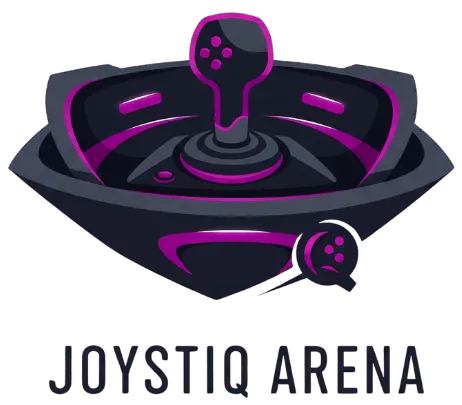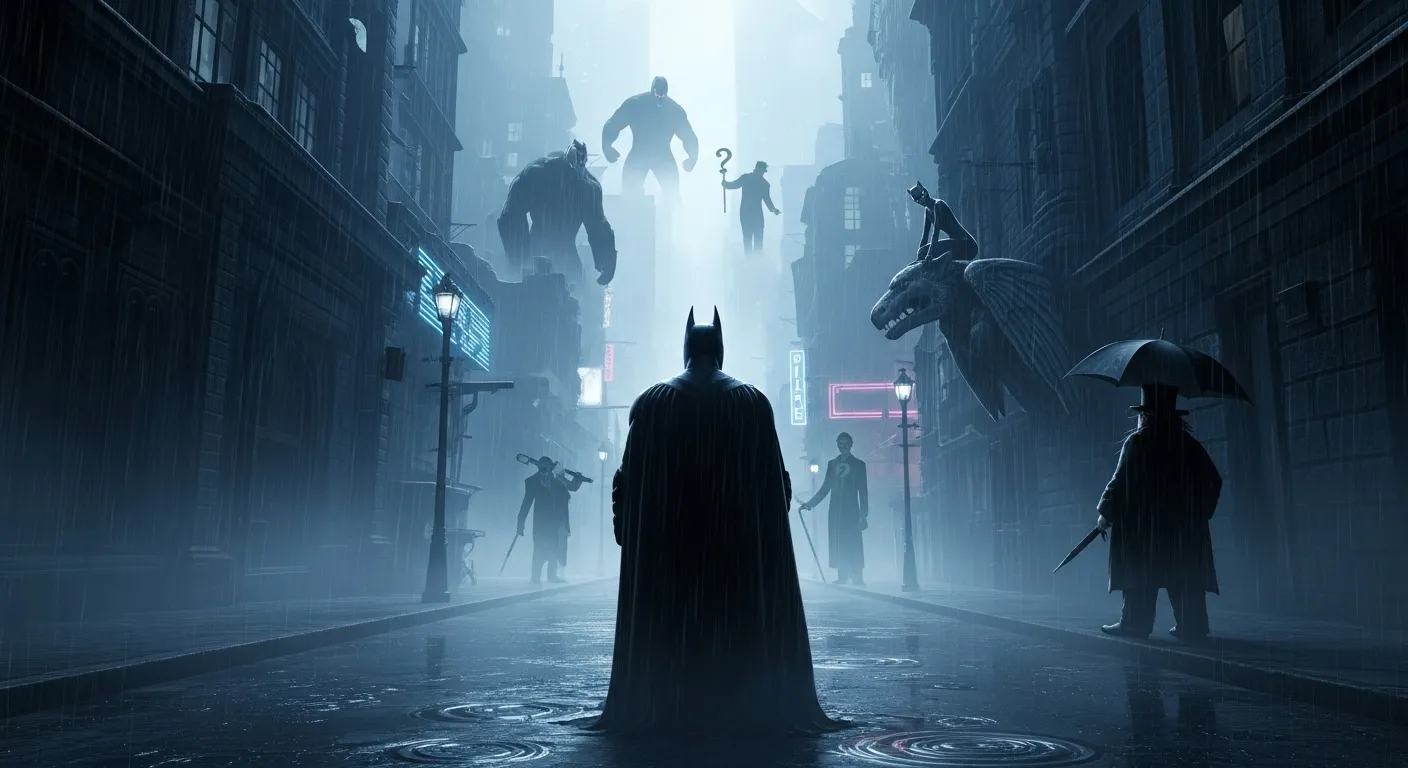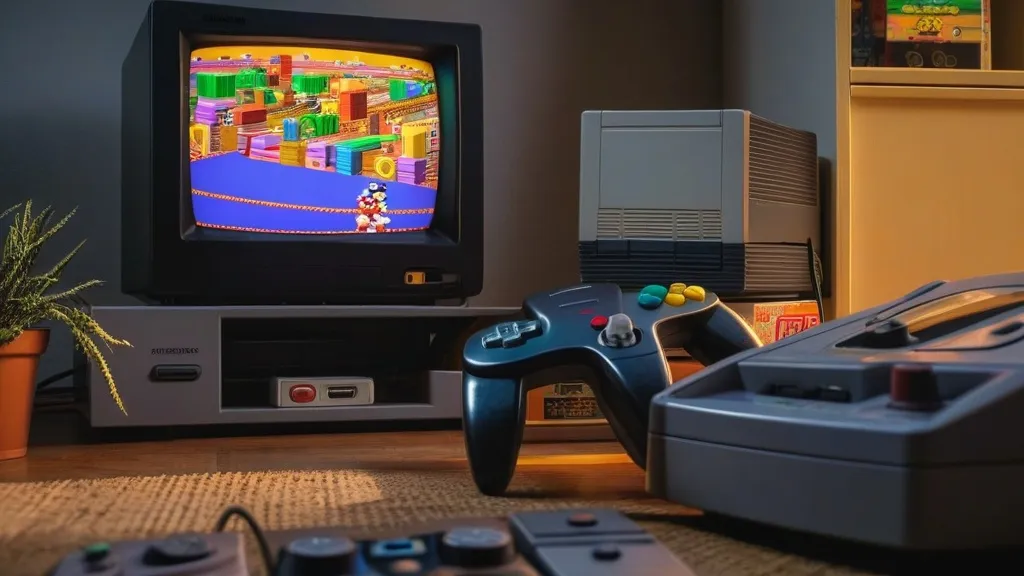PS3 Release Date Secrets Fans Missed
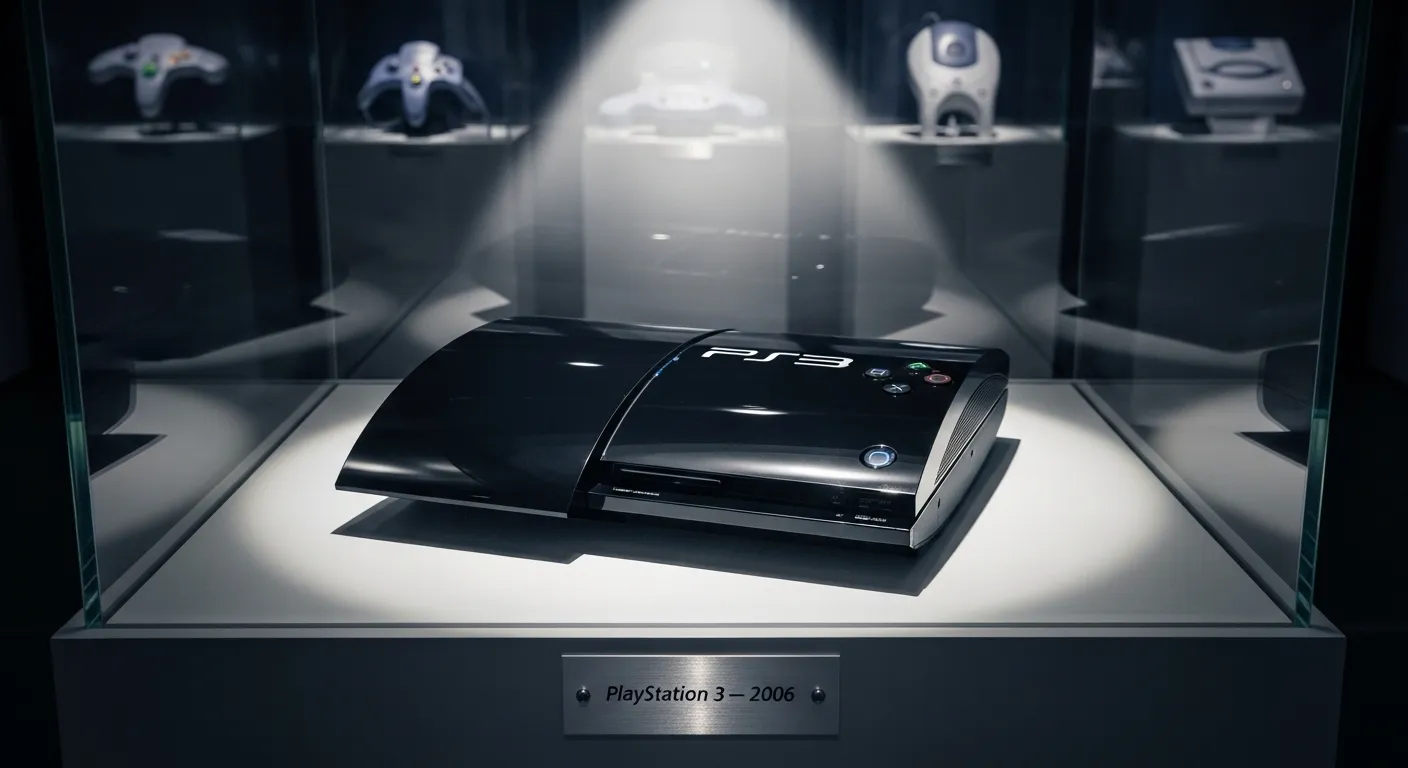
I still remember the first time I typed ps3 release date into Google back in the mid-2000s. Everyone was scrambling for scraps of information, forums buzzing, PlayStation fans arguing over leaks, and the occasional cryptic Sony press line that didn’t say much at all.
Looking back, it feels almost strange how big that moment was. A console launch shouldn’t have felt like a global event, but the PlayStation 3 launch date wasn’t just another tech release. It was basically the start of a new kind of console war, one that stretched into Blu-ray battles, online gaming shifts, and even pricing drama that people still joke about today.
And… honestly, a lot of folks forget how messy and fascinating the whole thing was.
So let’s dive into it properly. Not polished. Not museum-ready. Just how someone would actually talk about it.
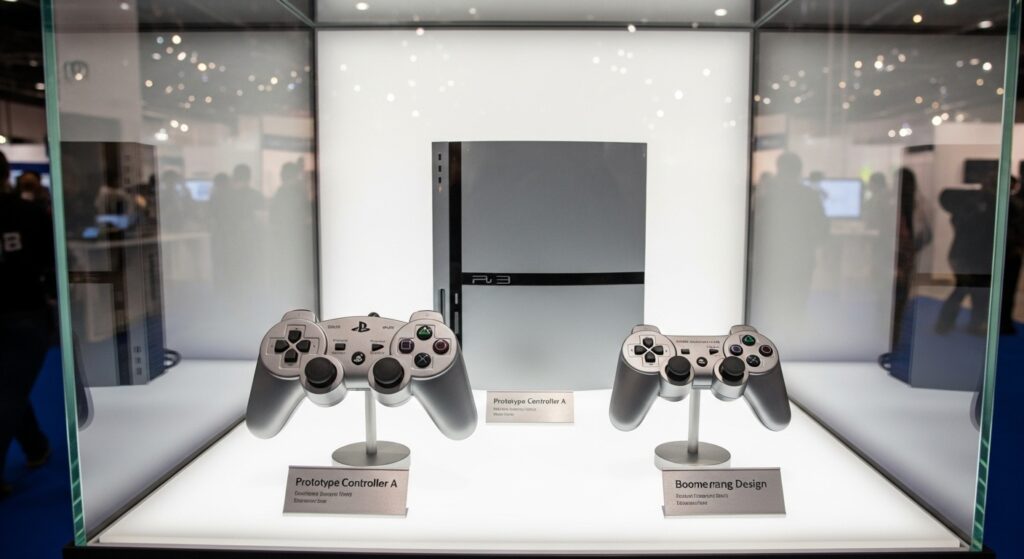
The Chaotic Build-Up Before the PS3 Debut Timeline
The road leading up to the PS3 original release wasn’t as smooth as Sony probably hoped. The PlayStation 2 had dominated practically everything — best-selling console of all time, a huge library, and a massive cultural footprint. So naturally, hype for the next generation was unreal.
But then Sony started talking about the PS3 like it was some kind of alien technology.
- Cell processor
- Blu-ray drive
- Next-level GPU
- 1080p gaming (as if everyone owned a 1080p TV in 2006)
It sounded futuristic — maybe too futuristic. Almost like Sony was promising a console built five years ahead of its time, and depending on who you ask, maybe they sort of did.
This giant leap forward created production headaches. Blu-ray was new, expensive, and slow to manufacture. And because the PS3 relied on it heavily, the PS3 debut timeline kept slipping. Even insiders weren’t fully sure when units would be ready.
If you’re interested in exploring more about the PS3 era and similar classics, check out our Retro Games section for deeper dives.
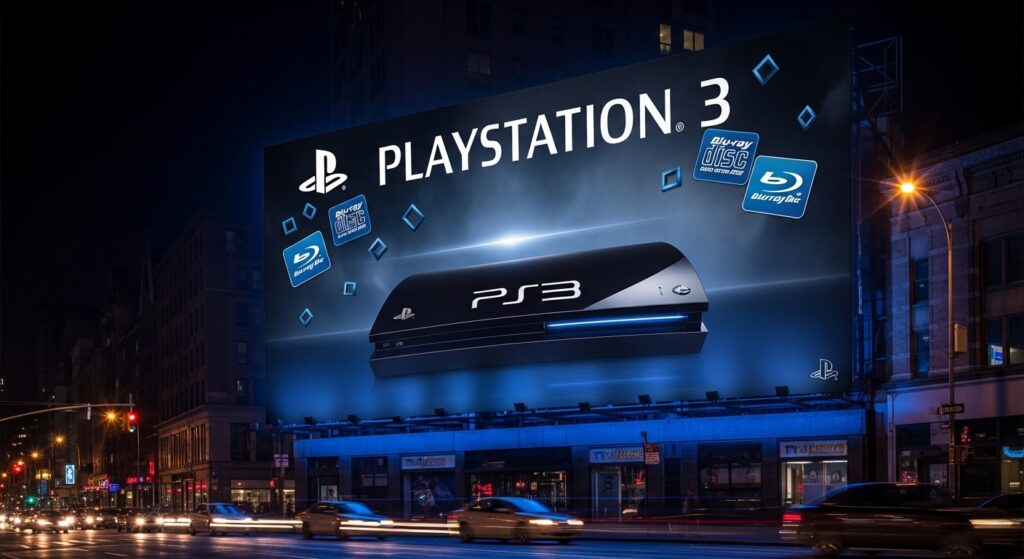
PS3 Regional Release Dates: The Split That Made Fans Furious
When the official dates finally dropped, gamers worldwide didn’t exactly cheer in sync. The PS3 regional release dates were split in a way that still annoys some European fans to this day.
Here’s the real breakdown:
| Region | Release Date | Notes |
| Japan | November 11, 2006 | Smaller unit allocation, sold out instantly |
| North America | November 17, 2006 | Huge launch events, big crowds |
| Europe | March 23, 2007 | Delayed due to Blu-ray diode shortages |
| Australia | March 23, 2007 | Same batch as EU |
Europe waited four extra months.
Four. Months.
Sony claimed it was because of Blu-ray production shortages. And yeah, technically they weren’t wrong — manufacturing Blu-ray diodes for the drives was a nightmare at the time. But if you were a European fan watching the U.S. and Japan celebrate while you sat there twiddling your thumbs… “shortages” probably didn’t cut it emotionally.
People were flipping imported PS3 consoles for ridiculous money online. Some even bought Japanese models before realizing games weren’t region-locked… but movies were, all thanks to Blu-ray region coding.
It was pure chaos, the kind of launch drama you only truly appreciate when looking back through the lens of Retro Games and the wider PS3 release history.
PS3 Release Year Context: 2006 Was Just a Weird Tech Moment
Looking back at the PS3 release year, 2006 feels like a weird glitch in tech history. HD TVs were just starting to become mainstream. Online gaming wasn’t universal. Digital stores were still young.
Yet here came this gigantic, over-engineered black monolith with curved edges and shiny plastic that collected fingerprints like a crime scene.
Sony made a console that belonged in 2012, not 2006.
This created a strange mismatch:
The PS3 was too advanced for the general market but not advanced enough to skip some early problems.
- Games were expensive to make due to the Cell architecture.
- Developers complained about complexity.
- Ports looked worse than Xbox 360 versions early on.
Ironically, years later, the same architecture allowed the PS3 to shine with exclusives like The Last of Us, Killzone 2, God of War III, and Uncharted 2. But early on? It was rough.
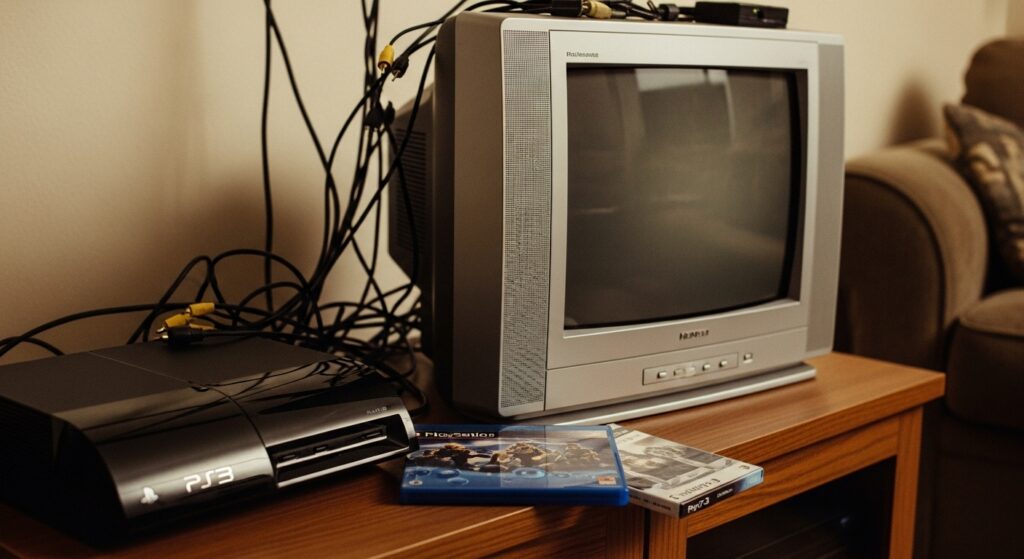
The PS3 Launch Price: The Moment Everyone Went “Wait… What?”
Let’s be honest: this part is unforgettable.
The PS3 launch price was legendary, for all the wrong reasons.
Sony unveiled two models:
| Model | Price | Key Specs |
| 20GB Model | $499 USD | No Wi-Fi, fewer ports |
| 60GB Model | $599 USD | Full features, backward compatibility |
$599 was a… moment.
People joked. People screamed. People made memes years before memes were even “a thing.” Even today, gamers still reference that price tag whenever a company drops something wildly overpriced.
But here’s the thing: Sony wasn’t price-gouging for fun. The Blu-ray drive alone cost a fortune. The Cell processor? Also expensive. The hardware inside the PS3 was honestly worth more than the console’s price tag at the time. Sony reportedly lost hundreds of dollars per unit sold just to get the system into homes.
The PS3 was a future-proofed machine being sold in a present that simply wasn’t ready for it.
Still… hearing “five hundred and ninety-nine US dollars” during that E3 presentation?
Yeah. We all felt that one.
For more context on how this moment shaped the PS3 release history, you can dig deeper into our Retro Games section.
PS3 Models Release Dates: When the Console Finally Evolved
The original PS3 (fat model) was kind of a chonky beast. Heavy. Curvy. Glossy like someone buffed it with car wax. And it ran hot. Not quite a PC-tower hot, but hot enough that people joked about warming their rooms in winter.
Eventually, Sony slimmed things down.
PS3 Slim Release Date
- September 1, 2009 (North America)
- September 3, 2009 (Japan)
- September 3, 2009 (Europe)
The Slim wasn’t just thinner, it launched at $299, which is wild considering the original pricing chaos. This model basically revived the PS3’s reputation and sales. It was cooler, quieter, cheaper, and didn’t attract fingerprints like a magnet.
PS3 Super Slim Release Date
- October 2012
Kind of a last-hurrah redesign, the Super Slim looked like someone at Sony finally snapped and said “ENOUGH WITH THE FINGERPRINTS.” So they gave it sliding doors and a textured finish. It wasn’t the prettiest, but it was functional.
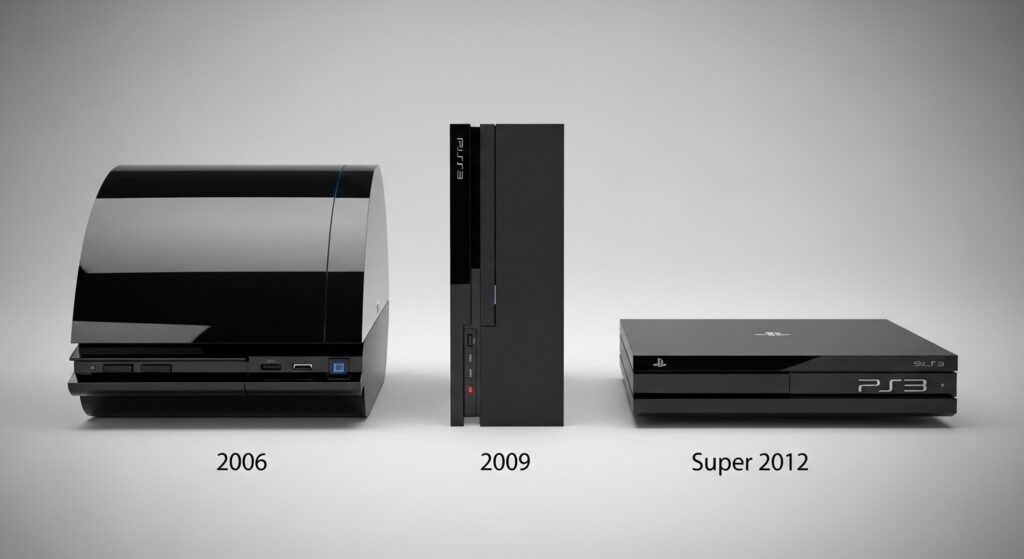
PS3 Hardware Specifications: The Overkill Machine
Everyone loves to talk about the PS3’s Cell processor. And yeah, it was powerful, ridiculously so. Too powerful for its own good, if you’re being honest. Developers initially struggled to harness it properly.
Here’s the simplified breakdown:
- Cell Broadband Engine (3.2 GHz)
- RSX “Reality Synthesizer” GPU (by NVIDIA)
- 256 MB XDR RAM + 256 MB GDDR3 VRAM
- Blu-ray disc drive
- HDMI output
- Wi-Fi (except 20GB version)
- Upgradeable HDD
At the time, some people complained the RAM was too low, and they weren’t wrong. But Sony bet heavily on the unique architecture to compensate.
It was complicated but incredibly capable if developers learned how to tame it.
PS3 Games at Launch: The Lineup That Was… Fine?
If you look at the PS3 games at launch, you’ll see a mix of solid but not spectacular titles. This is normal for console launches, but considering the hype, the lineup felt a little lighter than expected.
Some of the notable launch titles:
- Resistance: Fall of Man (the standout)
- Ridge Racer 7
- Call of Duty 3
- Genji: Days of the Blade (yes… the giant enemy crab meme game)
- Madden NFL 07
- MotorStorm (not day-one, but close enough)
Resistance honestly carried the U.S. launch on its back. It showed what the PS3 could do once developers figured out the hardware.
The early days were slower, though. The real PS3 magic wouldn’t hit until 2009–2013.

PS3 History and Timeline: A Rollercoaster That Eventually Paid Off
If you plot the PS3 history and timeline, it looks like a messy line graph, big dip at the start, big rise near the end.
- 2005: Console revealed
- 2006: Launch + pricing backlash
- 2007: Struggles with multiplatform ports
- 2008–2009: Exclusives start improving
- 2009: Slim model revives sales
- 2010–2013: Golden era of exclusives
- 2012: Super Slim launches
- 2016–2017: Production ends in phases
- 2020s: Retrospective admiration grows
By the end of its life, the PS3 wasn’t just “the expensive console.” It became the machine behind some of PlayStation’s most beloved games.
It took time, patience, and a few redesigns… but it got there.
PS3 Console Generations: How It Fit Into Sony’s Bigger Picture
The PS3 sits in a weird yet important spot between the PS2 (legend) and the PS4 (another legend). Almost like a middle child who got in trouble early but grew up into someone impressive.
Here’s the rough Sony PlayStation release timeline to show where it lands:
| Console | Release Year |
| PlayStation 1 | 1994 |
| PlayStation 2 | 2000 |
| PlayStation 3 | 2006 |
| PlayStation 4 | 2013 |
| PlayStation 5 | 2020 |
PS3 was the experimental one, the bold one. The one Sony used to push Blu-ray, advanced CPUs, online services, trophies, and tons of modern ideas.
And those risks shaped the PS4’s extremely smooth launch later on.
PS3 Sales History: A Slow Start That Somehow Ended in a Comeback
If you look at the PS3 sales history, it almost feels like studying two different consoles trapped inside one lifespan. The early phase was… brutal. The price scared people away, and the Xbox 360 had already been out for a year. Developers were used to the 360 architecture, so a lot of early PS3 ports looked worse. A bad look for a “future-proof” powerhouse.
Sony sold:
- ~3.5 million units in 2006
- ~9 million in 2007
- ~10 million in 2008
Not bad numbers in isolation. But compared to the PS2’s explosive trajectory, it felt like a stall.
Then, in 2009, something shifted.
The PS3 Slim launched with a more reasonable price and a cooler design. Sales shot up instantly. People who had waited (either patiently or stubbornly) finally jumped in. Games were improving. The online ecosystem was becoming more stable.
From 2009 onward, PS3’s story turned into an underdog comeback.
Here’s a rough rundown of total lifetime sales (approximate):
| Console | Lifetime Sales |
| PlayStation 2 | ~155 million |
| PlayStation 3 | ~87–88 million |
| Xbox 360 | ~84 million |
| Wii | ~101 million |
Ending the generation by surpassing the Xbox 360 globally wasn’t something many analysts predicted early on. It took years of course correction, hardware revisions, exclusives, and price drops, but Sony pulled it off.
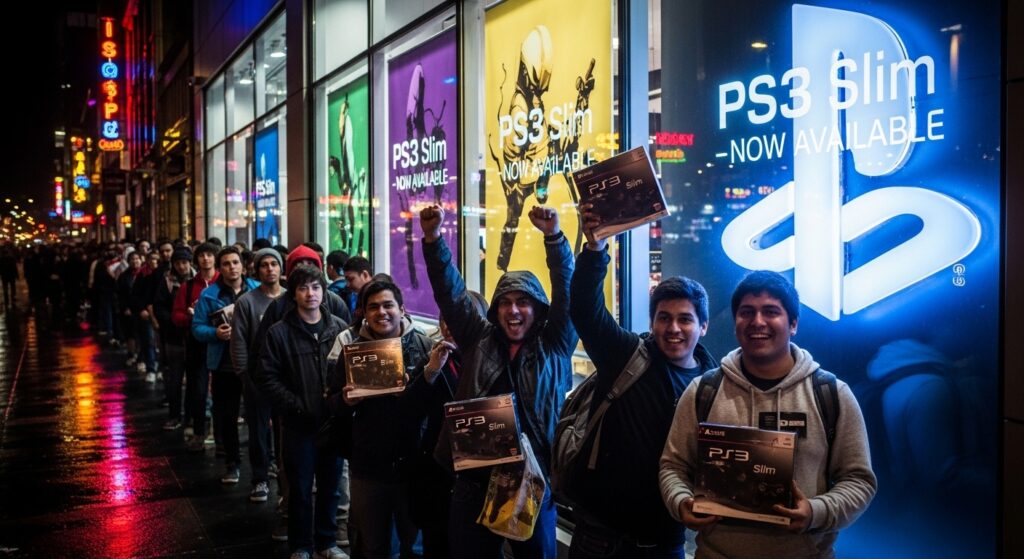
PS3 Lifecycle and Production End: A Long Road for a Complicated Console
The PS3 lifecycle is one of the longest of any Sony console. That alone says something. Despite its rocky start, the machine stayed relevant for over a decade.
Important milestones:
- 2006–2009: Early struggles, rising exclusive quality
- 2009–2012: Slim model dominance
- 2012–2016: Super Slim takes over, late-era games still releasing
- 2017: Last units produced in Japan
- 2017–2020: Gradual global phase-out of support
Sony officially ended production in Japan in May 2017, marking the end of a long and bumpy but ultimately meaningful run.
Some people assume the PS3 died earlier because the PS4 took off so quickly in 2013. But no, PS3 kept quietly receiving games even into 2017, especially sports franchises, JRPGs, and late cross-platform releases.
In a weird way, the PS3 aged gracefully. Slower than its siblings, sure, but with a lot of heart.
The Late-Era Games That Defined the PS3’s Redemption
People talk about The Last of Us a lot, and for good reason. But the PS3’s final years had a vibe that’s hard to explain unless you lived through it. It felt like developers had finally tamed the beast completely.
A few late-gen highlights:
- The Last of Us (2013)
- Grand Theft Auto V (2013)
- BioShock Infinite (2013)
- Metal Gear Solid V: Ground Zeroes (2014)
- Dark Souls II (2014)
The console that once struggled to run early multiplatform games smoothly was now delivering some of the most ambitious titles of the era.
The weirdest part?
If you compare early 2006 titles to the ones in 2013, it feels like two totally different generations, same hardware, completely different results.
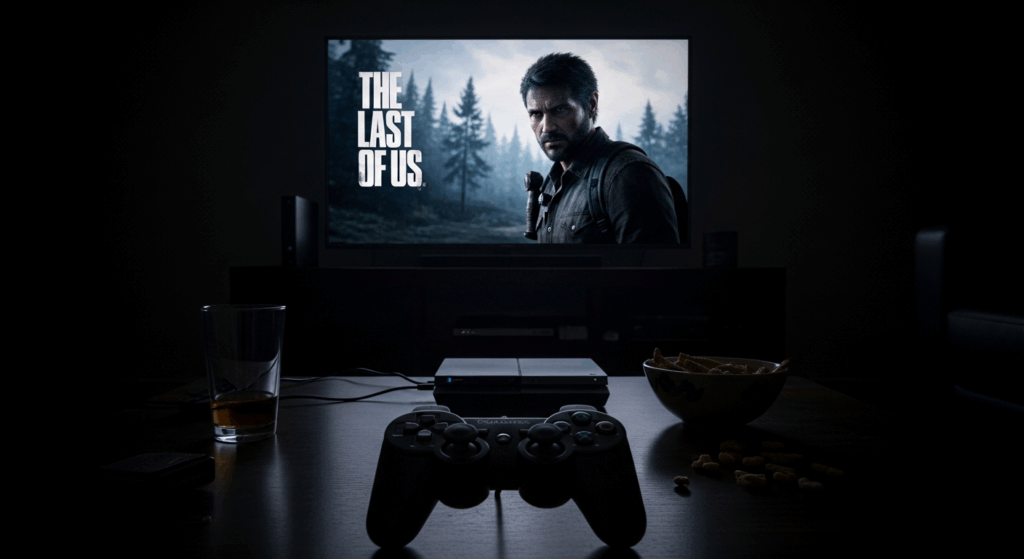
PS3 vs PS4 Comparison: A Generational Gap Bigger Than It Looked
People love to compare the PS3 and PS4, usually boiling it down to “one struggled early, the other didn’t.” But the PS3 vs PS4 comparison is a bit more nuanced.
Table: PS3 vs PS4 Core Differences
| Feature | PS3 | PS4 |
| CPU | Cell Broadband Engine | x86-64 AMD Jaguar |
| GPU | NVIDIA RSX | AMD Radeon-based |
| Unified RAM | No (split 256/256) | Yes (8GB GDDR5) |
| Optical Drive | Blu-ray | Blu-ray |
| Launch Price | $499/$599 | $399 |
| Ease of Development | Difficult | Very easy |
| Online Services | PSN (early issues) | Mature PSN, stable |
| Backward Compatibility | Limited (early models only) | Via PS Now (streaming) |
A few thoughts without over-polishing them:
- The PS4 felt simple, almost deliberately avoiding the “exotic hardware” trap of the PS3.
- Developers jumped on board quickly because the architecture was familiar.
- Sony priced the PS4 smartly at $399, echoing lessons learned from the PS3 launch.
The PS3 felt like Sony’s “experimental” era.
The PS4 felt like Sony’s “let’s fix everything and dominate again” era.
And it worked.
How the PS3 Release Date Changed Blu-ray vs HD-DVD
One forgotten part of the PS3 original release is how it basically killed HD-DVD. Without the PS3, the Blu-ray format war might’ve dragged on longer, maybe even gone the other way.
Here’s why:
- Every PS3 included a Blu-ray drive
- Millions of PS3 units = millions of Blu-ray players
- Movie studios followed the install base
- HD-DVD didn’t stand a chance
People forget the PS3 was one of the cheapest Blu-ray players on the market for years. Sony didn’t just launch a console, they launched a format army without saying it out loud.
The “PS3 helped Blu-ray win” narrative isn’t just speculation. It’s backed by timeline data and adoption curves. The PS3 debut timeline overlaps perfectly with Blu-ray’s rise.
If the console had launched a year later? A totally different story.
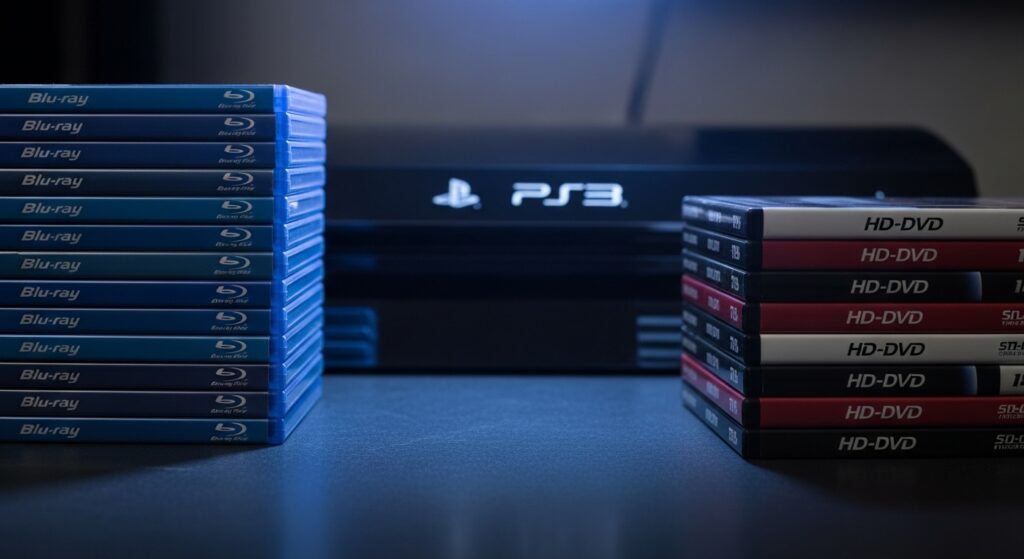
PS3 Online Evolution: From Rough Start to Something Solid
Online gaming on PS3 has its own mini-history. Early PSN felt like a beta version of what it later became.
Some early PS3 online quirks:
- Random disconnects
- Slow store updates
- PSN outages
- Limited social features
- Basic chat system
But Sony improved it year after year. Firmware updates were constant. Some felt like they took forever to install (yes… memories of that progress bar still haunt people). But they mattered.
By 2012–2013, PSN was smooth, reliable, and competitive with Xbox Live. Achievement hunters also remember the introduction of trophies, which weren’t even available at launch. A whole chunk of early games got retroactive trophy updates (while some did not… sorry, Resistance fans).
Small things, but they shaped modern PlayStation identity.
The PS3 Era’s Signature Exclusives: A Quick Stroll Through the Icons
It would be strange not to mention some exclusives that helped define the PS3 era. Sony hit its stride with studios like Naughty Dog, Insomniac, Guerrilla, Santa Monica, and Sucker Punch.
A few major titles that anchored the console:
- Uncharted 2 & 3
- God of War III
- inFAMOUS
- Killzone 2 & 3
- Gran Turismo 5
- LittleBigPlanet
- Journey
This period was when Sony’s “cinematic single-player experience” identity really formed. Today’s PS4 and PS5 storytelling roots can be traced all the way back to PS3’s stronger mid-to-late era.
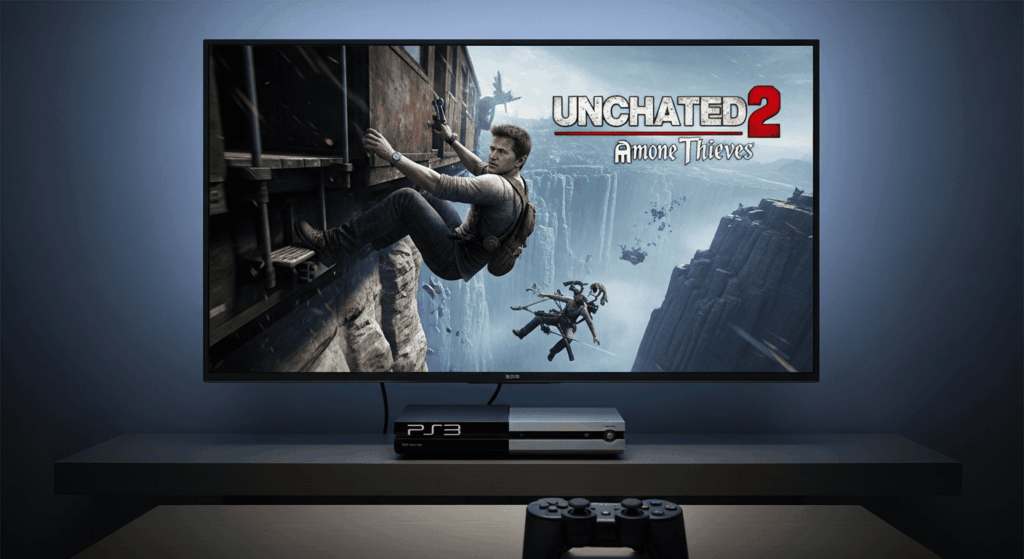
PS3’s Influence on the Next Generation of Consoles
A lot of what the PS3 introduced, sometimes awkwardly, sometimes ahead of its time, became standard later:
- Digital game sales
- Cloud saves
- HD media playback
- Online accounts
- Trophies/achievements
- Frequent firmware updates
- Emphasis on exclusives
Even the mistakes became lessons:
- Overpriced hardware → PS4’s $399 launch
- Hard-to-develop architecture → PS4’s PC-like design
- Slow early UI → PS4’s optimized dashboard
Sony doesn’t talk about it much, but the PS3 shaped their entire future strategy.
The Funny: Weird, and Forgotten PS3 Moments
Sometimes it’s these little things that make the PS3 era feel so… lived in.
A few:
- The giant Spider-Man movie font logo (why Sony, why)
- The “giant enemy crab” meme during E3 2006
- People flipping PS3 units on eBay for thousands
- The Sixaxis controller shipping without rumble
- The shock when DualShock 3 finally arrived
- Folding@Home turning your PS3 into a science project
- PS Home, the virtual world that felt like an early Metaverse experiment
The PS3 era was chaotic, experimental, unpredictable, and accidentally hilarious.
You kind of had to be there.
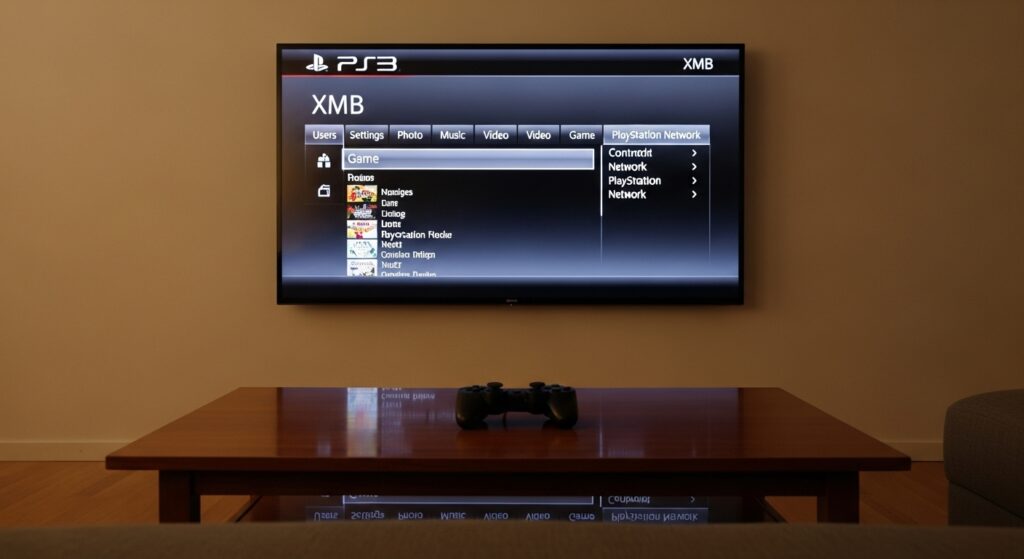
Sony PlayStation Release Timeline: Putting It All Into Perspective
Here’s a quick clean look at the Sony PlayStation release timeline, showing just how spaced-out (or not) each generation actually was:
| PlayStation Console | Release Year | Gap From Previous |
| PS1 | 1994 | — |
| PS2 | 2000 | 6 years |
| PS3 | 2006 | 6 years |
| PS4 | 2013 | 7 years |
| PS5 | 2020 | 7 years |
The PS3 sits right in the middle of PlayStation’s evolution, one foot in the past, one foot stretching awkwardly into the future.
It wasn’t the cleanest generation. But it was an important one.
And Then You Look Back at the PS3 Release Date… and It All Makes Sense
When you think about the PS3 release date now, and the era it dropped into, it feels like a console too ambitious for its moment, yet too iconic to ever fade away.
Maybe that’s the real secret people missed.
Sony took a risk — a messy, expensive, complicated risk. And somehow, through redesigns, legendary exclusives, aggressive price cuts, and sheer stubborn determination, the PS3 clawed its way into becoming a classic.
Not because it was perfect.
But because it wasn’t.
If you love revisiting moments like this, our Retro Games collection offers more deep dives into consoles with unforgettable histories.
And for something completely different but equally iconic, check out our breakdown of the most dangerous Batman villains.
Release Date Secrets Fans Missed
The PS3’s Strange Relationship With Backward Compatibility
A small but weirdly important piece of the PS3 story is its backward compatibility—or BC, for short. The PlayStation 2 had set expectations sky-high, so people naturally assumed they could pop in their PS2 discs and the PS3 would just… play them flawlessly.
And… well, sometimes it did. Sometimes it didn’t.
The launch PS3 models included full hardware-based backward compatibility, complete with the original Emotion Engine chip. Those early units are still highly sought after today (and infamously louder—but that’s a whole other topic).
If you enjoy deep dives into console strengths, weaknesses, and quirks, you’ll find more breakdowns in our Console Reviews section.
But Sony quickly phased that out:
- First by removing the Emotion Engine
- Then by using partial software emulation
- Then by removing PS2 disc support entirely
The one sentence summary: backward compatibility on PS3 went from “wow that’s awesome” to “hope you like downloading PS2 Classics” pretty fast.
This isn’t a complaint. Just something that gets forgotten when people romanticize the PS3. The system had a super complicated identity—half cutting-edge future machine, half clinging to legacy games, half struggling to even figure out what it wanted to be.
Yeah… that’s three halves. That’s the PS3 for you.
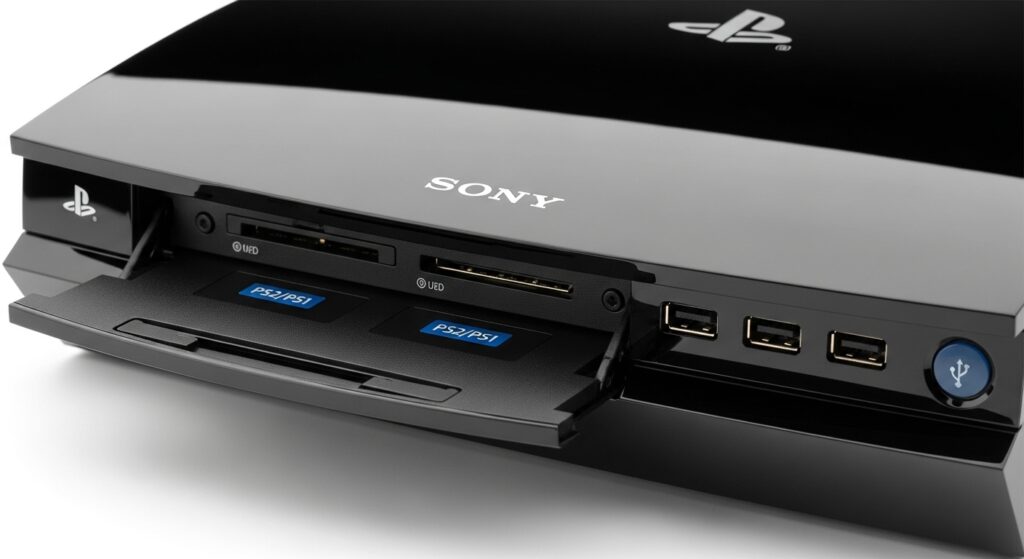
The Odd Little Features Everyone Forgot PS3 Had
Every console generation has those features that feel massive at launch and then quietly disappear in people’s memories. The PS3 had… a lot of these.
Here are a few:
1. Folding@Home
Your PS3 could donate processing power to medical research when idle. No joke.
2. Linux Installation Support
For a while, Sony let you install Linux on your PS3. Then they removed the feature and got sued over it. Wild times.
3. PS Home
If you weren’t there: imagine a proto-metaverse where people stand in digital plazas doing nothing.
4. Web Browser
Barely worked, but technically “worked.”
5. Video Store + Themes + Avatars
The XMB interface was clean. Honestly, almost too clean. Aesthetics aged well though.
6. DLNA Media Streaming
Your PS3 could even stream movies from your PC, turning the system into a surprisingly capable media hub. People forget just how handy this feature was back then.
The PS3 era wasn’t just about games—it was about Sony stuffing the console with every experimental idea the 2000s tech world had to offer. Not all of it stuck, sure, but it made the PS3 feel… alive. More like an evolving gadget than a static gaming box.
For more insights into features that made consoles stand out, check out our detailed breakdowns in Console Reviews.
The Controller Drama: Sixaxis vs DualShock 3
Remember how the PS3 originally shipped with a controller that didn’t have rumble? Sony said vibration interfered with the new Sixaxis motion tech (which… okay, sure). Later they quietly brought back rumble with the DualShock 3, and suddenly no one cared about Sixaxis tilt controls anymore.
A few quirks:
- The Sixaxis was super lightweight. Almost “toy-like.”
- The DualShock 3 felt better, but heavier.
- Most early games forced tilt mechanics awkwardly.
- Later games barely used motion controls at all.
The PS3 controller generation is kind of like someone trying a new haircut and instantly realizing they regret it.
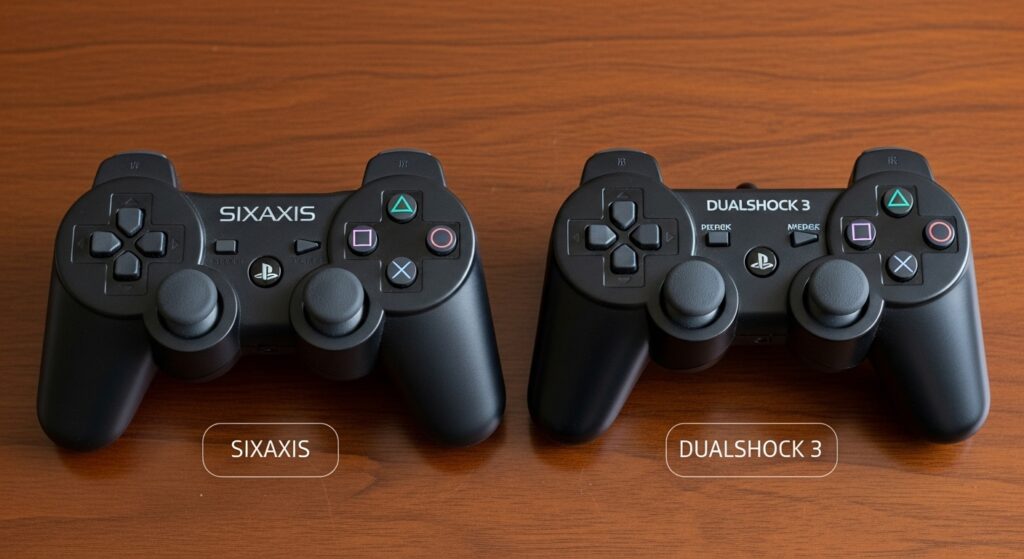
PS3 Multiplayer: Free, Fun, but Sometimes Frustrating
One massive advantage the PS3 had over its competition: online play was free. No subscription needed. Just make a PSN account and hop in.
But, uh… you could feel the “free.”
Servers were inconsistent. Voice chat quality felt like talking through an intercom inside a tunnel. And the 2011 PSN outage? Yeah, people still bring that up.
Still, for many players, the PS3 was where their online gaming life really started. Games like:
- Call of Duty: Modern Warfare 2
- Battlefield 3
- LittleBigPlanet
- GTA Online (early version)
- Uncharted multiplayer
It wasn’t always smooth. But it was accessible, and that mattered.
The Strangest Thing About the PS3 Release Year? It Aged Into a Classic
It’s kind of funny thinking back on the PS3 release year now. In 2006, a lot of people joked that the console was overhyped, too expensive, too complicated, and maybe even too experimental for its own good.
But now?
Now the PS3 feels like one of the most interesting consoles ever made—the kind that might not win every argument, but definitely sparks the most conversations. It’s like that one friend who slowly grows on you until you realize you can’t imagine the group without them.
If you enjoy takes like this on hardware that aged better than expected, you’ll find more perspectives in our Console Reviews section.
Nothing else has ever launched with:
- a brand-new media format
- a futuristic CPU
- a notoriously difficult architecture
- a steep price tag
- a split global release
- and still came out on top years later
The PS3 wasn’t just a console.
It was a gamble, a lesson, and a weirdly lovable machine.
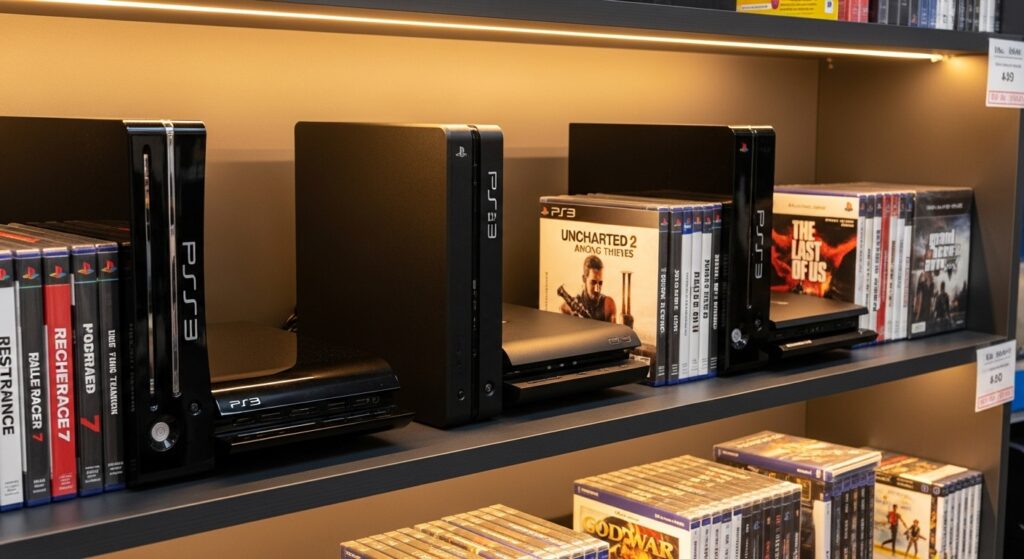
The Last Wave of PS3 Fans: And Why the Community Still Exists
Even today, you’ll see PS3 players updating trophy guides, replaying exclusives, keeping servers active, modding systems, or collecting hardware variants. The PS3 community feels unusually nostalgic.
Some reasons:
- The XMB interface is timeless
- The exclusives aged remarkably well
- The Slim and Super Slim models are reliable
- Retro collectors love the backward-compatible units
- The console sits at a good balance of price + history
And because it’s right on the edge between “retro” and “modern,” it hits a unique emotional spot. Old enough to feel vintage. New enough to still be fun.
The PS3 has quietly crossed into that warm space where people revisit systems not for their specs, but for the memories.
The PS3 Debut Timeline: The Quick Summary No One Ever Gives
If you need a simple, human-readable snapshot of the entire chaotic debut, here it is:
- 2005: Sony reveals PS3 in dramatic fashion
- Early 2006: Rumors of delays begin
- Mid 2006: Sony confirms staggered releases
- November 11, 2006: Japan release
- November 17, 2006: U.S. release
- March 23, 2007: Europe + Australia release
- 2007–2008: Rough reputation, high price, slow adoption
- 2009: PS3 Slim launches → momentum shifts
- 2010–2013: Exclusive-heavy era
- 2012: Super Slim releases
- 2017: Production officially ends
That’s the PS3 debut if you compress it. Messy. Ambitious. A slow climb that eventually turned into something iconic.
Why the PS3 Original Release Still Feels So Different From Newer Generations
The launch of the PS3 wasn’t sleek. It wasn’t calculated. It wasn’t perfectly timed. It was… dramatic. A bit chaotic. A little stubborn. And honestly, more memorable because of it.
Today, console launches feel:
- predictable
- market-tested
- streamlined
- safe
The PS3 launch felt like a company throwing everything it had into one futuristic box and saying, “Okay, let’s hope this works.”
Modern launches don’t hit that way anymore.
The PS3 was the last truly wild, high-stakes console gamble of its era.
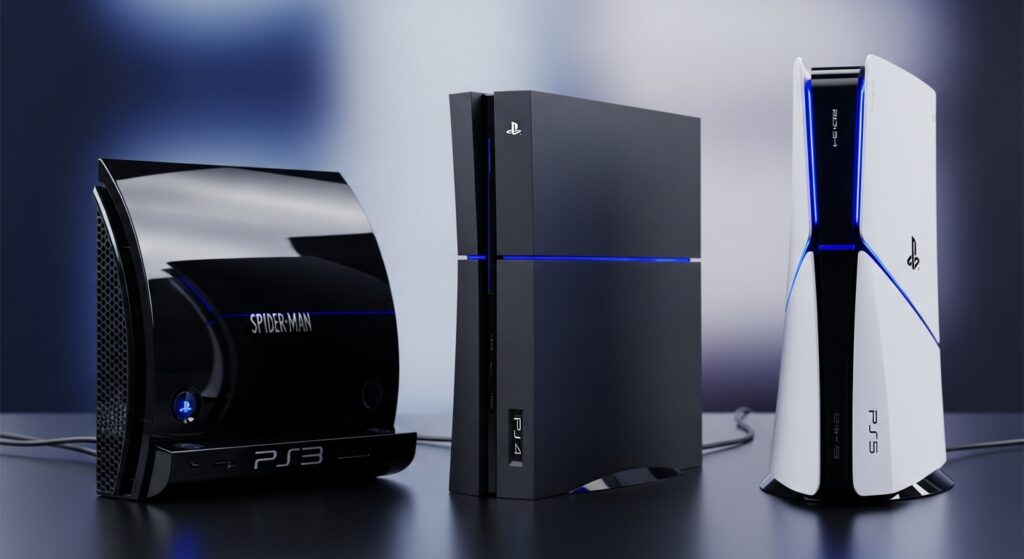
And so the PS3 release date isn’t just a date… it’s a turning point
When people search for the ps3 release date, they usually want one simple answer:
November 2006.
(Unless you’re in Europe, then it’s March 2007.)
But that date is just the surface. Under it sits a whole shift in console history—Blu-ray winning, Sony learning from mistakes, developers wrestling with architecture, online gaming maturing, exclusives redefining genres.
It’s not just a date.
It’s a timestamp for when gaming pivoted.
When everything started feeling more… modern, I guess.
Funny how some dates echo like that.
Anyway, that’s enough philosophizing for a console launch. Let’s hit the FAQs before this turns into something too tidy.
FAQs: Pulled From Real “People Also Ask” Queries
1. When did the PS3 officially come out?
The PS3 launched on November 11, 2006 in Japan, November 17, 2006 in North America, and March 23, 2007 in Europe and Australia. The staggered release happened because of Blu-ray component shortages.
2. Why was the PS3 so expensive at launch?
Sony loaded the PS3 with high, tech (and expensive) bits such as the Blu, ray drive and the Cell processor. The production cost was more than the selling price, which is what caused that notorious $599 price to appear.
3. What games launched with the PS3?
The biggest early standout was Resistance: Fall of Man, along with Ridge Racer 7, Call of Duty 3, Genji: Days of the Blade, and a few sports titles.
4. When did the PS3 Slim come out?
The PS3 Slim released in September 2009, lowering the price and dramatically boosting sales. It’s considered the turning point for the console.
5. When did Sony stop making the PS3?
Production ended in Japan in May 2017, with other regions phasing out around the same time. Yes—PS3 lived a surprisingly long life.

William Anderson | Your source for Console Reviews, Indie Spotlights, Gaming Gear, Retro Games, and Strategy Guides. Let’s play!
